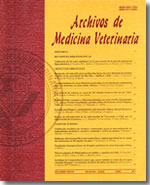Morphological characterization of the egg capsule of the sea louse Caligus rogercresseyi
Main Article Content
Abstract
The sea louse, Caligus rogercresseyi, is a marine ectoparasite living on the skin of several salmonid species. Studies on its life cycle have focused mainly on host living stages but no investigations have been conducted regarding the egg, the egg capsule, or its embryonic development. Since the knowledge of early developmental stages of Caligus is scarce, to propose any control measure preventing the parasite reaching its infective stage is difficult. As a way to contribute to the knowledge of the reproductive biology of this parasite, we propose to perform a characterisation of the morphological ultrastructure of the egg capsule using both light and electron microscopy. The light microscopy reveals a capsule wall, built of six main layers, three of which have dark solid bands of color comprised of external, middle and inner dense layers separated by two clear inner and outer layers. All of the five layers are surrounded by an external layer of mucous. Transmission electron microscopy reveals a more complex constitution: the mucus layer corresponds to a triple layer. The dense outer layer consists of four sub layers while the outer clear layer is made up of two distinct sub-layers separated by a thin dark layer; internally there is a middle dense layer. The inner clear layer is 51 nm at its thinnest portion, but can reach 2.4 microns as part of the wall of the capsule. The innermost layer corresponds to the chorion surrounding the egg.

